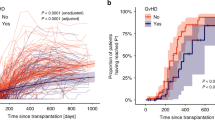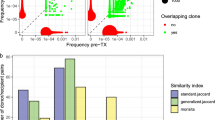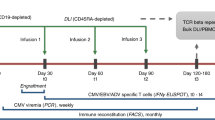Summary:
The factors affecting T cell reconstitution post haematopoietic cell transplantation (HCT) are not well characterised. We carried out a longitudinal analysis of T cell reconstitution in 32 HCT recipients during the first 12 months post transplant. We analysed reconstitution of naïve, memory and effector T cells, their diversity and monitored thymic output using TCR rearrangement excision circles (TRECs). Thymic-independent pathways were responsible for the rapid reconstitution of memory and effector T cells less than 6 months post HCT. Thymic-dependent pathways were activated between 6 and 12 months in the majority of patients with naïve T cell numbers increasing in parallel with TREC levels. Increasing patient age, chronic GVHD and T cell depletion (with or without pretransplant Campath-1H) predicted low TREC levels and slow naïve T cell recovery. Furthermore, increasing patient age also predicted high memory and effector T cell numbers. The effects of post HCT immunosuppression, total body irradiation, donor leucocyte infusions, T cell dose and post HCT infections on T cell recovery were also analysed. However, no effects of these single variables across a variety of different age, GVHD and T cell depletion groups were apparent. This study suggests that future analysis of the factors affecting T cell reconstitution and studies aimed at reactivating the thymus through therapeutic intervention should be analysed in age-, GVHD- and TCD-matched patient groups.
This is a preview of subscription content, access via your institution
Access options
Subscribe to this journal
Receive 12 print issues and online access
$259.00 per year
only $21.58 per issue
Buy this article
- Purchase on SpringerLink
- Instant access to full article PDF
Prices may be subject to local taxes which are calculated during checkout






Similar content being viewed by others
References
Devine SM, Adkins DR, Khoury H et al. Recent advances inallogeneic hematopoietic stem-cell transplantation. J Lab Clin Med 2003; 141: 7–32.
Burnett AK, Eden OB . The treatment of acute leukaemia. Lancet 1997; 349: 270–275.
Clift RA, Appelbaum FR, Thomas ED . Treatment of chronic myeloid leukemia by marrow transplantation. Blood 1993; 82: 1954–1956.
Horowitz MM, Bortin MM . The role of registries in evaluating the results of bone marrow transplantation. In: Treleaven J (ed). Bone Marrow Transplantation in Practice 1992. Churchill Livingstone: Edinburgh, pp 367–377.
Davies SM, Wagner JE, Shu XO et al. Unrelated donor bone marrow transplantation for children with acute leukemia. J Clin Oncol 1997; 15: 557–565.
Gustafsson A, Remberger M, Winiarski J, Ringden O . Unrelated bone marrow transplantation in children: outcome and a comparison with sibling donor grafting. Bone Marrow Transplant 2000; 25: 1059–1065.
Hows JM, Yin JL, Marsh J et al. Histocompatible unrelated volunteer donors compared with HLA nonidentical family donors in marrow transplantation for aplastic anemia and leukemia. Blood 1986; 68: 1322–1328.
Marks DI, Cullis JO, Ward KN et al. Allogeneic bone marrow transplantation for chronic myeloid leukemia using sibling and volunteer unrelated donors. A comparison of complications in the first 2 years. Ann Intern Med 1993; 119: 207–214.
Feinstein L, Sandmaier B, Maloney D et al. Nonmyeloablative hematopoietic cell transplantation. Replacing high-dose cytotoxic therapy by the graft-versus-tumor effect. Ann N Y Acad Sci 2001; 938: 328–337.
Michallet M, Bilger K, Garban F et al. Allogeneic hematopoietic stem-cell transplantation after nonmyeloablative preparative regimens: impact of pretransplantation and posttransplantation factors on outcome. J Clin Oncol 2001; 19: 3340–3349.
Morecki S, Gelfand Y, Nagler A et al. Immune reconstitution following allogeneic stem cell transplantation in recipients conditioned by low intensity vs myeloablative regimen. Bone Marrow Transplant 2001; 28: 243–249.
Nagler A, Aker M, Or R et al. Low-intensity conditioning is sufficient to ensure engraftment in matched unrelated bone marrow transplantation. Exp Hematol 2001; 29: 362–370.
Ash RC, Horowitz MM, Gale RP et al. Bone marrow transplantation from related donors other than HLA- identical siblings: effect of T cell depletion. Bone Marrow Transplant 1991; 7: 443–452.
Gilmore MJ, Patterson J, Ivory K et al. Standardization of T-cell depletion in HLA matched bone marrow transplantation. Br J Haematol 1986; 64: 69–75.
Prentice HG, Blacklock HA, Janossy G et al. Depletion of T lymphocytes in donor marrow prevents significant graft- versus-host disease in matched allogeneic leukaemic marrow transplant recipients. Lancet 1984; 1: 472–476.
McGlave P, Bartsch G, Anasetti C et al. Unrelated donor marrow transplantation therapy for chronic myelogenous leukemia: initial experience of the National Marrow Donor Program. Blood 1993; 81: 543–550.
Hansen JA, Gooley TA, Martin PJ et al. Bone marrow transplants from unrelated donors for patients with chronic myeloid leukemia. N Engl J Med 1998; 338: 962–968.
Davies SM, Shu XO, Blazar BR et al. Unrelated donor bone marrow transplantation: influence of HLA A and HLA B incompatability on outcome. Blood 1995; 86: 1636–1642.
Hongeng S, Krance RA, Bowman LC et al. Outcomes of transplantation with matched-sibling and unrelated-donor bone marrow in children with leukaemia. Lancet 1997; 350: 767–771.
Kernan NA, Bartsch G, Ash RC et al. Analysis of 462 transplantations from unrelated donors facilitated by the National Marrow Donor Program. N Engl J Med 1993; 328: 593–602.
Oakhill A, Pamphilon DH, Potter MN et al. Unrelated donor marrow transplanation for children with relapsed acute lymphoblastic leukaemia in second complate remmision. Br J Haematol 1996; 94: 574–578.
Ochs L, Shu XO, Miller J et al. Late infections after allogeneic bone marrow transplantations: comparison of incidence in related and unrelated donor transplant recipients. Blood 1995; 86: 3979–3986.
Small TN, Avigan D, Dupont B et al. Immune reconstitution following T-cell depleted bone marrow transplantation: effect of age and posttransplant graft rejection prophylaxis. Biol Blood Marrow Transplant 1997; 3: 65–75.
Snyder DS, Chao NJ, Amylon MD et al. Fractionated total body irradiation and high-dose etoposide as a preparatory regimen for bone marrow transplantation for 99 patients with acute leukemia in first complete remission. Blood 1993; 82: 2920–2928.
Madrigal JA, Scott I, Arguello R et al. Factors influencing the outcome of bone marrow transplants using unrelated donors. Immunol Rev 1997; 157: 153.
Korbling M, Anderlini P, Hematology TA . Peripheral blood stem cell versus bone marrow allotransplantation: does the source of hematopoietic stem cells matter? Blood 2001; 98: 2900–2908.
Small TN, Papadopoulos EB, Boulad F et al. Comparison of immune reconstitution after unrelated and related T-cell-depleted bone marrow transplantation: effect of patient age and donor leukocyte infusions. Blood 1999; 93: 467–480.
Storek J, Espino G, Dawson MA et al. Low B-cell and monocyte counts on day 80 are associated with high infection rates between days 100 and 365 after allogeneic marrow transplantation. Blood 2000; 96: 3290–3293.
Storek J, Gooley T, Witherspoon RP et al. Infectious morbidity in long-term survivors of allogeneic marrow transplantation is associated with low CD4 T cell counts. Am J Hematol 1997; 54: 131–138.
Dumont-Girard F, Roux E, van Lier RA et al. Reconstitution of the T-cell compartment after bone marrow transplantation: restoration of the repertoire by thymic emigrants. Blood 1998; 92: 4464–4471.
Mackall CL, Fleisher TA, Brown MR et al. Age, thymopoiesis, and CD4+ T-lymphocyte regeneration after intensive chemotherapy. N Engl J Med 1995; 332: 143–149.
Roux E, Dumont-Girard F, Starobinski M et al. Recovery of immune reactivity after T-cell-depleted bone marrow transplantation depends on thymic activity. Blood 2000; 96: 2299–2303.
Niehues T, Rocha V, Filipovich AH et al. Factors affecting lymphocyte subset reconstitution after either related or unrelated cord blood transplantation in children–a Eurocord analysis. Br J Haematol 2001; 114: 42–48.
Weinberg K, Blazar BR, Wagner JE et al. Factors affecting thymic function after allogeneic hematopoietic stem cell transplantation. Blood 2001; 97: 1458–1466.
Douek DC, McFarland RD, Keiser PH et al. Changes in thymic function with age and during the treatment of HIV infection. Nature 1998; 396: 690–695.
Douek DC, Vescio RA, Betts MR et al. Assessment of thymic output in adults after haematopoietic stem-cell transplantation and prediction of T-cell reconstitution. Lancet 2000; 355: 1875–1881.
Hochberg EP, Chillemi AC, Wu CJ et al. Quantitation of T-cell neogenesis in vivo after allogeneic bone marrow transplantation in adults. Blood 2001; 98: 1116–1121.
Chung B, Barbara-Burnham L, Barsky L, Weinberg K . Radiosensitivity of thymic interleukin-7 production and thymopoiesis after bone marrow transplantation. Blood 2001; 98: 1601–1606.
Baars PA, Maurice MM, Rep M et al. Heterogeneity of the circulating human CD4+ T cell population. Further evidence that the CD4+CD45RA-CD27- T cell subset contains specialized primed T cells. J Immunol 1995; 154: 17–25.
Hamann D, Baars PA, Rep MH et al. Phenotypic and functional separation of memory and effector human CD8+ T cells. J Exp Med 1997; 186: 1407–1418.
Hintzen RQ, de Jong R, Lens SM et al. Regulation of CD27 expression on subsets of mature T-lymphocytes. J Immunol 1993; 151: 2426–2435.
Gregersen PK, Hingorani R, Monteiro J . Oligoclonality in the CD8+ T-cell population. Analysis using a multiplex PCR assay for CDR3 length. Ann NY Acad Sci 1995; 756: 19–27.
Singer CR, Tansey PJ, Burnett AK . T lymphocyte reconstitution following autologous bone marrow transplantation. Clin Exp Immunol 1983; 51: 455–460.
Witherspoon RP, Lum LG, Storb R, Thomas ED . In vitro regulation of immunoglobulin synthesis after human marrow transplantation. II. Deficient T and non-T lymphocyte function within 3–4 months of allogeneic, syngeneic, or autologous marrow grafting for hematologic malignancy. Blood 1982; 59: 844–850.
Aspinall R, Andrew D . Thymic involution in aging. J Clin Immunol 2000; 20: 250–256.
Hollander GBS . Thymic T-cell development. In: Ferrara JD. HJ; Burakoff, SJ, (eds). Graft-vs-Host Disease. New York: Marcel Decker, Inc., 1997, pp 1–50.
Mackall CL, Gress RE . Pathways of T-cell regeneration in mice and humans: implications for bone marrow transplantation and immunotherapy. Immunol Rev 1997; 157: 61–72.
Mackall CL, Gress RE . Thymic aging and T-cell regeneration. Immunol Rev 1997; 160: 91–102.
Mackall CL, Punt JA, Morgan P et al. Thymic function in young/old chimeras: substantial thymic T cell regenerative capacity despite irreversible age-associated thymic involution. Eur J Immunol 1998; 28: 1886–1893.
Lewin SR, Heller G, Zhang L et al. Direct evidence for new T-cell generation by patients after either T-cell-depleted or unmodified allogeneic hematopoietic stem cell transplantation. Blood 2002; 100: 2235–2242.
Hulstaert F, Hannet I, Deneys V et al. Age-related changes in human blood lymphocyte subpopulations. II. Varying kinetics of percentage and absolute count measurements. Clin Immunol Immunopathol 1994; 70: 152–158.
Kurashima C, Utsuyama M, Kasai M et al. The role of thymus in the aging of Th cell subpopulations and age-associated alteration of cytokine production by these cells. Int Immunol 1995; 7: 97–104.
Mackall CL, Bare CV, Granger LA et al. Thymic-independent T cell regeneration occurs via antigen-driven expansion of peripheral T cells resulting in a repertoire that is limited in diversity and prone to skewing. J Immunol 1996; 156: 4609–4616.
Mackall CL, Fry TJ, Bare C et al. IL-7 increases both thymic-dependent and thymic-independent T-cell regeneration after bone marrow transplantation. Blood 2001; 97: 1491–1497.
Atkinson K, Hansen JA, Storb R et al. T-cell subpopulations identified by monoclonal antibodies after human marrow transplantation. I. Helper-inducer and cytotoxic-suppressor subsets. Blood 1982; 59: 1292–1298.
Connors M, Kovacs JA, Krevat S et al. HIV infection induces changes in CD4+ T-cell phenotype and depletions within the CD4+ T-cell repertoire that are not immediately arestored by antiviral or immune-based therapies. Nat Med 1997; 3: 533–540.
Forman SJ, Nocker P, Gallagher M et al. Pattern of T cell reconstitution following allogeneic bone marrow transplantation for acute hematological malignancy. Transplantation 1982; 34: 96–98.
Jendro MC, Ganten T, Matteson EL et al. Emergence of oligoclonal T cell populations following therapeutic T cell depletion in rheumatoid arthritis. Arthritis Rheum 1995; 38: 1242–1251.
Mackall CL, Fleisher TA, Brown MR et al. Lymphocyte depletion during treatment with intensive chemotherapy for cancer. Blood 1994; 84: 2221–2228.
Globerson A . T lymphocytes and aging. Int Arch Allergy Immunol 1995; 107: 491–497.
Globerson A, Effros RB . Ageing of lymphocytes and lymphocytes in the aged. Immunol Today 2000; 21: 515–521.
Timm JA, Thoman ML . Maturation of CD4+ lymphocytes in the aged microenvironment results in a memory-enriched population. J Immunol 1999; 162: 711–717.
George AJ, Ritter MA . Thymic involution with ageing: obsolescence or good housekeeping? Immunol Today 1996; 17: 267–272.
Kendall MD, Johnson HR, Singh J . The weight of the human thymus gland at necropsy. J Anat 1980; 131: 483–497.
Steinmann GG, Klaus B, Muller-Hermelink HK . The involution of the ageing human thymic epithelium is independent of puberty. A morphometric study. Scand J Immunol 1985; 22: 563–575.
Ferrara JLM, Deeg HJ . Graft-versus-host-disease. N Eng J Med 1991; 324: 667–674.
Fukushi N, Arase H, Wang B et al. Thymus: a direct target tissue in graft-versus-host reaction after allogeneic bone marrow transplantation that results in abrogation of induction of self-tolerance. Proc Natl Acad Sci USA 1990; 87: 6301–6305.
Ghayur T, Seemayer TA, Xenocostas A, Lapp WS . Complete sequential regeneration of graft-vs-host-induced severely dysplastic thymuses. Implications for the pathogenesis of chronic graft-vs-host disease. Am J Pathol 1988; 133: 39–46.
Hollander GA, Widmer B, Burakoff SJ . Loss of normal thymic repertoire selection and persistence of autoreactive T cells in graft vs host disease. J Immunol 1994; 152: 1609–1617.
Muller-Hermelink HK, Sale GE, Borisch B, Storb R . Pathology of the thymus after allogeneic bone marrow transplantation in man. A histologic immunohistochemical study of 36 patients. Am J Pathol 1987; 129: 242–256.
van den Brink MR, Moore E, Ferrara JL, Burakoff SJ . Graft-versus-host-disease-associated thymic damage results in the appearance of T cell clones with anti-host reactivity. Transplantation 2000; 69: 446–449.
Brochu S, Rioux-Masse B, Roy J et al. Massive activation-induced cell death of alloreactive T cells with apoptosis of bystander postthymic T cells prevents immune reconstitution in mice with graft-versus-host disease. Blood 1999; 94: 390–400.
Dulude G, Roy DC, Perreault C . The effect of graft-versus-host disease on T cell production and homeostasis. J Exp Med 1999; 189: 1329–1342.
Krenger W, Rossi S, Piali L, Hollander GA . Thymic atrophy in murine acute graft-versus-host disease is effected by impaired cell cycle progression of host pro-T and pre-T cells. Blood 2000; 96: 347–354.
Hakim FT, Payne S, Shearer GM . Recovery of T cell populations after acute graft-vs-host reaction. J Immunol 1994; 152: 58–64.
Leposavic G, Obradovic S, Kosec D . In vivo modulation of the distribution of thymocyte subsets by female sex steroid hormones. Int Immunopharmacol 2001; 1: 1–12.
Leussink VI, Jung S, Merschdorf U et al. High-dose methylprednisolone therapy in multiple sclerosis induces apoptosis in peripheral blood leukocytes. Arch Neurol 2001; 58: 91–97.
Nambiar MP, Enyedy EJ, Fisher CU et al. Dexamethasone modulates TCR zeta chain expression and antigen receptor- mediated early signaling events in human T lymphocytes. Cell Immunol 2001; 208: 62–71.
Olsen NJ, Viselli SM, Fan J, Kovacs WJ . Androgens accelerate thymocyte apoptosis. Endocrinology 1998; 139: 748–752.
Szondy Z . Methylprednisolone and 2-chloroadenosine induce DNA fragmentation at different stages of human T-lymphocyte development. Immunol Lett 1997; 58: 59–65.
Van Laethem F, Baus E, Smyth LA et al. Glucocorticoids attenuate T cell receptor signaling. J Exp Med 2001; 193: 803–814.
Wiegers GJ, Stec IE, Klinkert WE et al. Bidirectional effects of corticosterone on splenic T-cell activation: critical role of cell density and culture time. Neuroendocrinology 2001; 73: 139–148.
Brenner MK, Grob JP, Prentice HG . The use of monoclonal antibodies in graft versus host disease prevention. Haematologia 1986; 19: 167–176.
Hale G, Zhang MJ, Bunjes D et al. Improving the outcome of bone marrow transplantation by using CD52 monoclonal antibodies to prevent graft-versus-host disease and graft rejection. Blood 1998; 92: 4581–4590.
Urbano-Ispizua A, Carreras E, Marin P et al. Allogeneic transplantation of CD34(+) selected cells from peripheral blood from human leukocyte antigen-identical siblings: detrimental effect of a high number of donor CD34(+) cells? Blood 2001; 98: 2352–2357.
Urbano-Ispizua A, Rozman C, Pimentel P et al. The number of donor CD3(+) cells is the most important factor for graft failure after allogeneic transplantation of CD34(+) selected cells from peripheral blood from HLA-identical siblings. Blood 2001; 97: 383–387.
Andrew D, Aspinall R . Il-7 and not stem cell factor reverses both the increase in apoptosis and the decline in thymopoiesis seen in aged mice. J Immunol 2001; 166: 1524–1530.
Bolotin E, Smogorzewska M, Smith S et al. Enhancement of thymopoiesis after bone marrow transplant by in vivo interleukin-7. Blood 1996; 88: 1887–1894.
Okamoto Y, Douek DC, McFarland RD, Koup RA . Effects of exogenous interleukin-7 on human thymus function. Blood 2002; 99: 2851–2858.
Howard JK, Lord GM, Matarese G et al. Leptin protects mice from starvation-induced lymphoid atrophy and increases thymic cellularity in ob/ob mice. J Clin Invest 1999; 104: 1051–1059.
Sfikakis PP, Kostomitsopoulos N, Kittas C et al. Tamoxifen exerts testosterone-dependent and independent effects on thymic involution. Int J Immunopharmacol 1998; 20: 305–312.
Oehme P, Hecht K, Jumatov J et al. Prevention of stress-induced involution of the thymus in rats by substance P (SP1-11) and its N-terminal fragment SP1-4. Pharmazie 1987; 42: 34–36.
Min D, Taylor P, Chung B et al. Protection from thymic epithelial cell injury by pre-BMT keratinocyte growth factor: a new approach to speed thymic reconstitution after lethal irradiation. In ASH San Francisco: Blood, 2000, pp 474a.
Acknowledgements
We thank Dr Daniel Douek for providing TREC standard constructs and offering helpful advice in optimising the TREC assay, the clinical and nursing staff of the BMT team at the Royal Free Hospital for help in collecting patient samples and providing access to the BMT database and Dr Rose Zamoyska for critically reviewing this manuscript.
Author information
Authors and Affiliations
Corresponding author
Additional information
Supported by the Anthony Nolan Bone Marrow Trust
Rights and permissions
About this article
Cite this article
Fallen, P., McGreavey, L., Madrigal, J. et al. Factors affecting reconstitution of the T cell compartment in allogeneic haematopoietic cell transplant recipients. Bone Marrow Transplant 32, 1001–1014 (2003). https://doi.org/10.1038/sj.bmt.1704235
Received:
Accepted:
Published:
Issue Date:
DOI: https://doi.org/10.1038/sj.bmt.1704235



